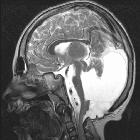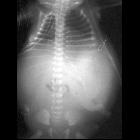cleft lip and / or palate







Cleft lip and palate is one of the commonest of neonatal facial anomalies. In ~80% of cases, the two features tend to occur together .
Epidemiology
It is estimated to occur with an incidence of ~1 in 700-to-1000 live births. This can increase to 4% for a sibling of a previously affected fetus and up to 10% for a sibling of two previously affected infants. There is a recognized racial predilection. For example, the United States, has one of the highest rates in terms of prevalence in American Indians (~4 in 1,000), followed by Asian (1.5-2.0 in 1,000), Caucasian (1 in 1,000) and African American (0.3 in 1,000) populations.
Pathology
The lip forms between the 4 and 7 weeks of pregnancy. The roof of the mouth (palate) is formed between the 6 and 9 weeks of pregnancy. The condition results during the 4 to 6 weeks of gestation from a failure of fusion of one or both of the medial nasal prominences. These initially occur as paired medial nasal processes and failure of fusion with each other or with the maxillary processes will result in cleft lip with or without a cleft palate. Clefts in the anterior palate disrupt this normal line of fusion, resulting in the discontinuity in the smooth, C-shape contour of the alveolar ridge at the junction between the lateral incisors and canine tooth sockets, extending posteriorly to the incisive foramen. Much less commonly, the defect may occur between the medial and lateral incisors.
In a bilateral cleft lip and palate, there is a pre-maxillary protrusion that is typically seen as a paranasal echogenic mass. The premaxillary protrusion results from instability of the facial structures during embryologic development, which produces uninhibited growth of the vomer and premaxillary bones and soft tissues. Although this occurs with a bilateral complete left lip and palate, it does not occur with other types of facial clefts or with cleft palate alone.
Genetics
In a sizable proportion, it is sporadic, although various inheritance patterns have been described .
Laterality
The majority are unilateral and when unilateral, it tends to occur on the left (70%)
Classification
Several classification systems exist. The Nyberg 1995 antenatal ultrasound classification system is one that correlates very well with the severity of the defect with outcomes and is divided into five types :
- type I: isolated cleft lip alone
- type II: unilateral cleft lip and palate
- type III: bilateral cleft lip and palate
- type IV: midline/median cleft lip and palate
- type V: facial clefts associated with the amniotic band syndrome or the limb-body-wall complex
An isolated cleft palate is almost impossible to diagnose in utero and is not part of this classification.
Associations
Other associated anomalies can occur in up to 30-50% of cases . They are protean and include
- aneuploidic syndromic: tends to occur with types II, III and IV
- non-aneuploidic syndromic
- ectrodactyly-ectodermal dysplasia-clefting syndrome-EEC syndrome
- frontonasal dysplasia
- Fryns syndrome
- Gorlin syndrome
- Juberg-Hayward syndrome
- Kallmann syndrome
- Majewski syndrome: short rib-polydactyly syndrome type II
- Nager syndrome
- oro-facial-digital syndrome type 1 (OFDS type 1): particularly tends to give a median cleft
- Roberts syndrome
- certain types of short rib-polydactyly syndromes, e.g. type IV
- Stickler syndrome
- TAR syndrome
- VACTERL association
- van der Woude syndrome (VWS)
- exposure to in utero substances
- non-aneuploidic non-syndromic
- Dandy-Walker continuum
- holoprosencephaly: often with type IV
- pentalogy of Cantrell
Radiographic features
Ultrasound
Sonographic features can be variable depending on the exact type of cleft anomaly. In general, an upper lip defect may be seen and is best appreciated on angled coronal scanning. A vertical hypoechoic region through the fetal upper lip usually represents the defect in cleft lipthe. This finding may be corroborated by a similar defect of the soft tissues of the upper lip overlying the maxilla in the axial plane.
The palate can be examined in the transverse (axial) plane. 3D ultrasound may further assist in diagnosis. It is good practice to comment on fetal swallowing in real time at the time the scan is performed.
Type-specific sonographic features include:
- type III: may be seen as a premaxillary echogenic mass
Ancillary sonographic features
- there can be polyhydramnios if the defect is severe and impairs swallowing
Treatment and prognosis
The overall prognosis is variable depending on associated anomalies with isolated lateral clefts (types I and II) having the best prognosis.
See also
Siehe auch:
- Pätau-Syndrom
- Amniotisches-Band-Syndrom
- Gorlin-Goltz-Syndrom
- VACTERL-Assoziation
- Trisomie 18
- Polyhydramnion
- Holoprosencephalie
- Roberts-Syndrom
- Fetales Valproat-Syndrom
- mesiodens
- Fryns-Syndrom
- Stickler-Syndrom
- Kurzripp-Polydaktylie-Syndrome
- Dandy Walker continuum
- Frontonasale Dysplasie
- Thrombozytopenie-Radiusaplasie-Syndrom
- Kallmann-Syndrom
- Varadi-Papp-Syndrom
- EEC syndrome
- Cantrell’sche Pentalogie
- OFM Nager-Syndrom
- hydantoin embryopathy
- van der Woude syndrome (VWS)
- orofaziale Spalten
- isolierte Gaumenspalte
- fetal cleft lip
- limb-body-wall complex
und weiter:
- obstetric curriculum
- Meckel-Syndrom
- Diastrophische Dysplasie
- Walker-Warburg-Syndrom
- dysencephalia spanchnocystica
- Gaumenspalte
- Salonen-Herva-Norio syndrome
- hydrolethalus
- dilantin embryopathy
- Wolf-Hirschhorn-Syndrom
- acrofacial dyostosis
- ectrodactyly-ectrodermal dysplasia-clefting syndrome
- Zephalozele
- Dubowitz-Syndrom
- Rosselli-Gulienetti-Syndrom
- van der Woude syndrome
- Loch in der Maxilla
- Lippenspalte

 Assoziationen und Differentialdiagnosen zu Lippen-Kiefer-Gaumen-Spalte:
Assoziationen und Differentialdiagnosen zu Lippen-Kiefer-Gaumen-Spalte:
















